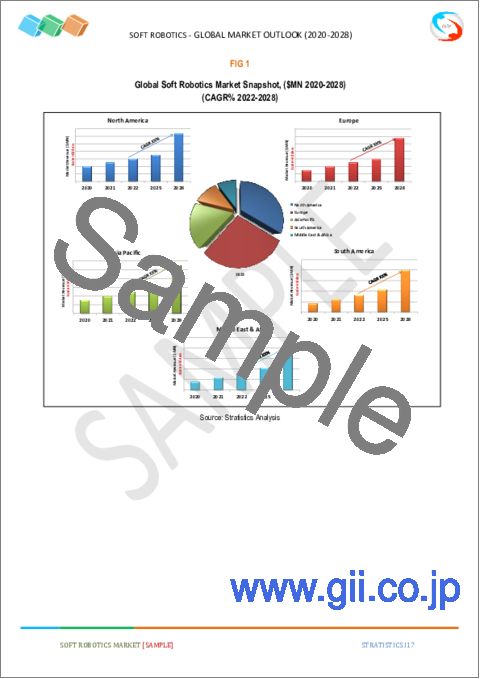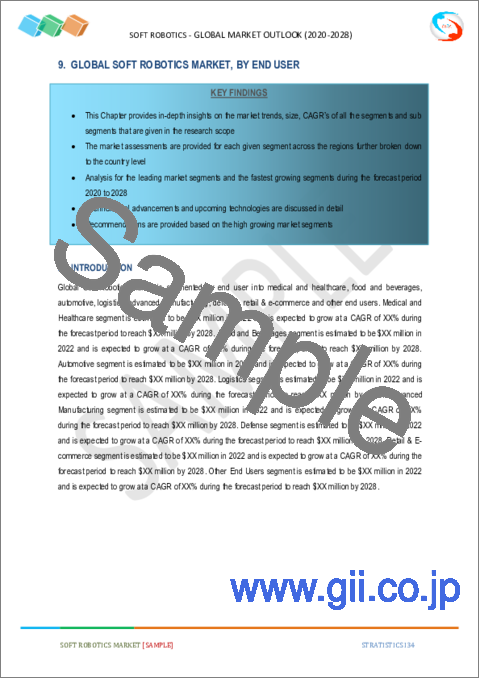|
|
市場調査レポート
商品コード
1235957
ソフトロボティクス市場:2028年までの予測- タイプ別(ウェアラブル、協働ロボット、ソフトグリッパー、インフレータブルロボット、その他タイプ)、モビリティ、コンポーネント、アプリケーションなどの世界分析Soft Robotics Market Forecasts to 2028 - Global Analysis By Type (Wearables, Co-Robots, Soft Grippers, Inflated Robots, Other Types), Mobility, Component, Application, and others |
||||||
|
● お客様のご希望に応じて、既存データの加工や未掲載情報(例:国別セグメント)の追加などの対応が可能です。 詳細はお問い合わせください。 |
|||||||
| ソフトロボティクス市場:2028年までの予測- タイプ別(ウェアラブル、協働ロボット、ソフトグリッパー、インフレータブルロボット、その他タイプ)、モビリティ、コンポーネント、アプリケーションなどの世界分析 |
|
出版日: 2023年03月03日
発行: Stratistics Market Research Consulting
ページ情報: 英文 175+ Pages
納期: 2~3営業日
|
- 全表示
- 概要
- 図表
- 目次
Stratistics MRCによると、ソフトロボティクスの世界市場は、2022年に1兆1,090億米ドルとなり、2028年には8兆7,170億米ドルに達すると予測され、予測期間中のCAGRは41%に達するとされています。
ソフト・ロボティクスとは、生き物のように従順な部品からロボットを作る技術です。これは主に、生き物がどのように動き、環境に適応しているかを参考にしたものです。硬い機械でできたロボットとは対照的に、ソフトなロボットは、タスクの完了のための柔軟性と適応性を高め、人間の近くで操作する際の信頼性を高めることができます。
世界保健機関(WHO)の最新報告によると、心血管疾患、がん、糖尿病、慢性呼吸器疾患などの非感染性疾患(NCDs)は、現在、世界の死因の71%近くを占めています。これらのNCDsによって毎年4100万人が亡くなっていることを物語っています。
市場力学
促進要因
医療・ヘルスケア産業におけるニーズの高まり
ヘルスケア産業は、ソフトロボティクスの主要な最終応用分野の一つです。これらのロボットは、手術、治療、診断など、医療におけるさまざまな治療プロセスで使用されています。低侵襲手術の需要は、ヘルスケア産業におけるソフトロボティクスの需要を促進すると予想されます。さらに、飲食品業界では、包装、配膳、検査に役立つソフトロボティクスが使用されています。自動化への欲求に伴い、ソフトロボティクスは食品・飲料分野でより普及すると予測されています。
阻害要因
導入コストの高さ
ソフトロボティクスの開発には、お金と時間の両面で大きな研究開発費が必要です。また、完成した製品を購入するためには、法外な価格を支払わなければならないため、新しい消費者やプレイヤーにとっては参入障壁となります。その結果、予測期間中、市場は制約を受けることになります。
機会
ソフトロボティクスの汎用性・柔軟性
一般的な金属製ロボットが硬いのに対し、ソフトロボティクスは柔軟性があるため、今後の成長機会につながります。また、ソフトロボティクス技術の進歩により、大きな物体の移動、自己修復、高所への移動などの機能を持つロボットの登場が予想されます。このようなロボットは、建設現場やその周辺での用途が拡大しており、人間のような柔軟性と組み合わせることで、市場の成長にさらなる弾みをつけると期待されています。ソフトロボティクスは、ナノマテリアルを含む柔軟で柔らかい素材で構成されているため、人間の筋肉のような生物学的な動作を模倣することができます。このようなソフトロボティクスの特性により、医療、産業、機関車など、さまざまな用途での利用が容易になり、市場の成長が促進されると予想されます。
脅威
ソフトロボティクスの限界
超高真空、微小重力、極端な温度、高エネルギー放射線など、宇宙空間で使用されるソフトロボティクスには大きな障害があります。また、剛体ロボットに比べて性能が低く、専門的な電子制御を必要とするため、ソフトロボティクスの管理は困難です。このような制約があるため、ソフトロボティクスの市場は阻害されています。
COVID-19の影響
ソフトウェアロボットの市場は、飲食品分野での自動化の進展や、ロボット関連の研究開発の拡大が主な要因となっています。世界各国の政府は、COVID-19問題にもかかわらず、R&Dへの様々な投資を開始し、ロボットデバイスの意義を世界に企業にアピールしています。
予測期間中、ウェアラブル(外骨格)分野が最も大きくなると予想される
ウェアラブル外骨格分野は、有利な成長を遂げると推定されます。外骨格は、倉庫や製造業の従業員を首、背中、肩の痛みから守り、また、重いものを繰り返し持ち上げることによってもたらされるその他の問題からも救うことができる、新しく開発された装置です。多くの科学者が、筋肉の動きを模倣したソフトで装着可能なロボットを開発しています。ゼネラルモーターズは、スウェーデンのビオサーボ社が開発したバッテリー駆動の外骨格グローブを作りました。アイアンハンド」グローブの各指にはセンサーとモーターが搭載されており、物を持ち上げたり持ったりするときに腕にかかる力の大きさに瞬時に反応します。
予測期間中、医療・ヘルスケア分野のCAGRが最も高くなると予想される
医療・ヘルスケア分野は、予測期間中に最も速いCAGR成長を遂げると予測されています。この市場セグメントは、さらに医療用、外科用、その他の用途に分類され、ソフトストレッチセンサー技術を扱っています。また、ソフトロボティクスは、患者や医療スタッフにとってより安全な環境で、極めて効果的な処置を行うことを可能にしています。人間と機械の安全な相互作用を確保するために、ヘルスケア分野の市場参入企業は、新しい製造ソリューションであるソフトロボティクスを外科手術や製薬などの分野に適用しています。また、ソフトロボティクスシステムは、従来の方法よりも綿密でタスクに特化したトレーニングが必要なため、世界中のヘルスケアセクターで急速に採用されています。
最もシェアの高い地域
アジア太平洋地域は、この技術が広く受け入れられ、家庭での生産が増加していることから、予測期間中に最大の市場シェアを占めると予想されます。また、ソフトロボティクスの分野における技術革新や進歩も、この地域のベンダーに大きな影響を受けています。外骨格は、労働災害を減らし、高齢者の雇用を拡大するために、いずれの国でも不可欠なものとみなされています。怪我や不自由な人を助け、高齢者社会をより長く労働力として維持できる可能性があるため、ロボット外骨格の作成に大きく投資を行っています。
CAGRが最も高い地域。
北米は、熟練労働者の豊富さと米国のハイエンド産業インフラの存在により、予測期間中最も高いCAGRを示すと予測されています。また、特に需要の高い加工食品パッケージング事業におけるプロセス技術の自動化に対する政府支出の増加が、同市場の最大株主となることを後押しすると考えられます。
主な発展。
2020年6月、Soft Robotics Incは、COVID-19パンデミックによる需要に対応するため、商業事業をさらに拡大するために$10MシリーズBを延長調達しました。
2017年11月、ABBと川崎重工は、「協働ロボット」と安全性、プログラミング、通信に関する業界共通のアプローチの作成に焦点を当てた協働ロボット自動化協力を発表
私たちのレポートが提供するもの
- 地域別・国別セグメントの市場シェア評価
- 新規参入企業への戦略的提言
- 2020年、2021年、2022年、2025年、2028年の市場データを網羅
- 市場促進要因(市場動向、制約要因、機会、脅威、課題、投資機会、推奨事項など)
- 市場推定に基づく主要なビジネスセグメントにおける戦略的な提言
- 競合情勢とその動向
- 詳細な戦略、財務、最近の動向を含む企業プロファイル
- サプライチェーンの動向は、最新の技術進歩をマッピングしています。
無料カスタマイズの提供
本レポートをご購入いただいたお客様には、以下の無料カスタマイズオプションのいずれかをご提供いたします。
- 企業プロファイルの作成
- 追加市場プレイヤーの包括的なプロファイリング(最大3名まで)
- キープレイヤーのSWOT分析(3名まで)
- 地域別セグメント
- お客様のご希望に応じて、主要国の市場推計・予測・CAGRを提供(注:フィージビリティチェック別。)
- 競合ベンチマーキング
- 製品ポートフォリオ、地理的プレゼンス、戦略的提携に基づく主要プレイヤーのベンチマーキング
目次
第1章 エグゼクティブサマリー
第2章 序文
- 概要
- ステークホルダー
- 調査範囲
- 調査手法
- データマイニング
- データ分析
- データ検証
- 調査アプローチ
- 調査情報源
- 1次調査情報源
- 2次調査情報源
- 仮定
第3章 市場動向分析
- 促進要因
- 抑制要因
- 機会
- 脅威
- アプリケーション分析
- エンドユーザー分析
- 新興市場
- COVID-19の影響
第4章 ポーターズファイブフォース分析
- 供給企業の交渉力
- 買い手の交渉力
- 代替品の脅威
- 新規参入業者の脅威
- 競争企業間の敵対関係
第5章 世界のソフトロボティクス市場:タイプ別
- ウェアラブル(外骨格)
- 協働ロボット
- ソフトグリッパー
- インフレータブルロボッ
- その他のタイプ
第6章 世界のソフトロボティクス市場:モビリティ別
- モバイル
- 固定
- その他のモビリティ
第7章 世界のソフトロボティクス市場:コンポーネント別
- サービス
- ソフトウェア
- ハードウェア
- コントロール
- アクチュエーター
- センサー
- モデリングおよび製造システム
- その他のハードウェア
第8章 世界のソフトロボティクス市場:アプリケーション別
- ヒューマノイドの研究開発
- 人間の運動補助
- ヒューマンマシンインターフェイスとインタラクション
- 移動と探索
- 医療および外科用途
- 操作
- リハビリテーションおよびウェアラブルロボット
第9章 世界のソフトロボティクス市場:エンドユーザー別
- 医療とヘルスケア
- 飲食品
- 自動車
- ロジスティクス
- 先進製造
- 小売およびeコマース
- その他のエンドユーザー
第10章 世界のソフトロボティクス市場:地域別
- 北米
- 米国
- カナダ
- メキシコ
- 欧州
- ドイツ
- 英国
- イタリア
- フランス
- スペイン
- その他欧州
- アジア太平洋地域
- 日本
- 中国
- インド
- オーストラリア
- ニュージーランド
- 韓国
- その他アジア太平洋地域
- 南米
- アルゼンチン
- ブラジル
- チリ
- その他南米
- 中東とアフリカ
- サウジアラビア
- アラブ首長国連邦
- カタール
- 南アフリカ
- その他中東
第11章 主な発展
- 契約、パートナーシップ、コラボレーション、合弁事業
- 買収と合併
- 新製品の発売
- 事業拡大
- その他の主要戦略
第12章 企業プロファイル
- Daqing Jiaotong University
- ABB Ltd.
- Roam Robotics
- Festo AG
- Yaskawa Electric Corporation
- Ekso Bionics Holdings Inc
- Bio Servo Technologies
- Cyberdyne Inc.
- F&P Robotics AG
- Soft Robotics Inc.
- Universal Robots A/S
- Kawasaki
- Weiss Robotics GmbH & Co. KG
- Zimmer Group
- SMC
- Destaco
List of Tables
- Table 1 Global Soft Robotics Market Outlook, By Region (2020-2028) ($MN)
- Table 2 Global Soft Robotics Market Outlook, By Type (2020-2028) ($MN)
- Table 3 Global Soft Robotics Market Outlook, By Wearables (Exoskeletons) (2020-2028) ($MN)
- Table 4 Global Soft Robotics Market Outlook, By Co-Robots (2020-2028) ($MN)
- Table 5 Global Soft Robotics Market Outlook, By Soft Grippers (2020-2028) ($MN)
- Table 6 Global Soft Robotics Market Outlook, By Inflated Robots (2020-2028) ($MN)
- Table 7 Global Soft Robotics Market Outlook, By Other Types (2020-2028) ($MN)
- Table 8 Global Soft Robotics Market Outlook, By Mobility (2020-2028) ($MN)
- Table 9 Global Soft Robotics Market Outlook, By Mobile (2020-2028) ($MN)
- Table 10 Global Soft Robotics Market Outlook, By Stationery (2020-2028) ($MN)
- Table 11 Global Soft Robotics Market Outlook, By Other Mobility's (2020-2028) ($MN)
- Table 12 Global Soft Robotics Market Outlook, By Component (2020-2028) ($MN)
- Table 13 Global Soft Robotics Market Outlook, By Services (2020-2028) ($MN)
- Table 14 Global Soft Robotics Market Outlook, By Software (2020-2028) ($MN)
- Table 15 Global Soft Robotics Market Outlook, By Hardware (2020-2028) ($MN)
- Table 16 Global Soft Robotics Market Outlook, By Controls (2020-2028) ($MN)
- Table 17 Global Soft Robotics Market Outlook, By Actuators (2020-2028) ($MN)
- Table 18 Global Soft Robotics Market Outlook, By Sensors (2020-2028) ($MN)
- Table 19 Global Soft Robotics Market Outlook, By Modeling and Manufacturing Systems (2020-2028) ($MN)
- Table 20 Global Soft Robotics Market Outlook, By Other Hardwares (2020-2028) ($MN)
- Table 21 Global Soft Robotics Market Outlook, By Application (2020-2028) ($MN)
- Table 22 Global Soft Robotics Market Outlook, By R&D of Humanoids (2020-2028) ($MN)
- Table 23 Global Soft Robotics Market Outlook, By Human Motor Assistance (2020-2028) ($MN)
- Table 24 Global Soft Robotics Market Outlook, By Human Machine Interface & Interaction (2020-2028) ($MN)
- Table 25 Global Soft Robotics Market Outlook, By Locomotion & Exploration (2020-2028) ($MN)
- Table 26 Global Soft Robotics Market Outlook, By Medical & Surgical Applications (2020-2028) ($MN)
- Table 27 Global Soft Robotics Market Outlook, By Manipulation (2020-2028) ($MN)
- Table 28 Global Soft Robotics Market Outlook, By Rehabilitation & Wearable Robots (2020-2028) ($MN)
- Table 29 Global Soft Robotics Market Outlook, By End User (2020-2028) ($MN)
- Table 30 Global Soft Robotics Market Outlook, By Medical and Healthcare (2020-2028) ($MN)
- Table 31 Global Soft Robotics Market Outlook, By Food and Beverages (2020-2028) ($MN)
- Table 32 Global Soft Robotics Market Outlook, By Automotive (2020-2028) ($MN)
- Table 33 Global Soft Robotics Market Outlook, By Logistics (2020-2028) ($MN)
- Table 34 Global Soft Robotics Market Outlook, By Advanced Manufacturing (2020-2028) ($MN)
- Table 35 Global Soft Robotics Market Outlook, By Defense (2020-2028) ($MN)
- Table 36 Global Soft Robotics Market Outlook, By Retail & E-commerce (2020-2028) ($MN)
- Table 37 Global Soft Robotics Market Outlook, By Other End Users (2020-2028) ($MN)
Note: Tables for North America, Europe, APAC, South America, and Middle East & Africa Regions are also represented in the same manner as above.
According to Stratistics MRC, the Global Soft Robotics Market is accounted for $1109 billion in 2022 and is expected to reach $8717 billion by 2028 growing at a CAGR of 41% during the forecast period. The precise branch of robotics known as "Soft Robotics" deals with creating robots out of incredibly obedient parts that are akin to those found in living things. It primarily borrows from how live things move and adjust to their environment. In contrast to robots made of rigid machinery, soft robots enable greater flexibility and adaptation for task completion as well as greater reliability when operating near humans.
According to the latest World Health Organization (WHO) report, non-communicable diseases (NCDs), such as cardiovascular disease, cancer, diabetes, and chronic respiratory diseases are currently responsible for almost 71% of global deaths. It accounts for 41 million people dying each year of these NCDs.
Market Dynamics:
Driver:
Increasing need in medical and health care industry
The healthcare industry is one of soft robots' major final application fields. These robots are used in a range of therapeutic processes in medicine, including surgery, therapy, and diagnosis. The demand for minimally invasive surgeries is expected to drive demand for soft robots in the healthcare industry. Additionally, in the food and beverage industry also soft robots are used which helps in packaging, serving, and inspection in the food and beverage sector. Along with the desire for automation, it is projected that soft robots would become more popular in the food and beverage sector.
Restraint:
High Cost of Installation
Soft robot development requires significant R&D expenditures in terms of both money and time. Since customers must fork over exorbitant prices for the finished product, this serves as a barrier to entry for new consumers and players. As a result, during the time of the forecast, the market is constrained.
Opportunity:
Versatility and Flexibility of Soft Robots
Soft robots have flexible natures as opposed to typical metallic robots, which have rigid natures, offering the market attractive future growth opportunities. Robots with the ability to move large objects, repair themselves, and scale great heights are anticipated to be introduced because to advancements in soft robotics technology. Given their expanding application in construction and associated activities, such characteristics are expected to give the market growth additional momentum when combined with flexibility similar to that of humans. Soft robots can mimic the biological actions of human muscles since they are constructed using flexible and soft materials, incorporating Nanomaterials. This trait of soft robots is anticipated to facilitate their use in a number of applications, including as medical, industrial, and locomotive, and hence promote market growth.
Threat:
Limitations of soft robots
Ultra - high vacuum, microgravity, temperature extremes, and high-energy radiation present substantial obstacles for soft robotics used in space conditions. Since they are less powerful than rigid robotics and require specialist electronic controls, soft robots can be difficult to manage. As a result of these constraints, the market for soft robots is hindered.
COVID-19 Impact
The market for software robots is primarily driven by the ongoing development of automation with in food and beverage sector as well as the ongoing expansion of robotics-related research and development. Governments from all around the world have started a variety of investments in R & D despite the COVID-19 issue to promote the significance of robotic devices to companies globally.
The Wearables (Exoskeletons) segment is expected to be the largest during the forecast period
The Wearables Exoskeletons segment is estimated to have a lucrative growth. Exoskeletons are a newly developed device that could shield and also save warehouse and manufacturing employees from neck, back, and shoulder pain as well as other problems brought on by heavy and repetitive lifting. Many scientists are creating soft, wearable robots that imitate the actions of muscles. General Motors created a battery-operated exoskeleton glove, which was created by the Swedish company Bioservo. Each finger on the "Iron Hand" glove features sensors and motors that react instantly to the amount of force being applied to the arm when lifting or holding an object.
The medical & healthcare segment is expected to have the highest CAGR during the forecast period
The medical & healthcare segment is anticipated to witness the fastest CAGR growth during the forecast period. This market segment, which is further segmented into applications for medical, surgical, and other purposes, deals with soft stretch sensor technology. Soft robotics also makes it possible for extremely effective procedures to be carried out in a setting that is safer for patients and medical staff. In order to ensure safe human-machine interaction, market participants in the healthcare sector are applying soft robotics, a novel manufacturing solution, in the surgical, pharmaceutical, and other sectors. Soft robotics systems are also being fast adopted by the worldwide healthcare sector since they require more thorough and task-specific training than conventional methods.
Region with highest share:
Asia Pacific is projected to hold the largest market share during the forecast period owing to the widespread acceptance of the technology and growing household production in the market. The innovation and advancement in the field of soft robotics are also greatly influenced by the regional vendors. Exoskeletons are viewed as essential in both nations for reducing workplace accidents and extending the employment of older workers. Because of their potential to help injured or crippled individuals and to keep elderly communities in the workforce longer, they are heavily making investments in the creation of robotic exoskeletons.
Region with highest CAGR:
North America is projected to have the highest CAGR over the forecast period, owing to the abundance of a skilled labour and the presence of high-end industrial infrastructure in the US. Additionally, increased government spending on process technology automation, particularly in the high-demand processed food packaging business, would assist the market become the largest shareholder.
Key players in the market
Some of the key players profiled in the Soft Robotics Market include: Daqing Jiaotong University, ABB Ltd., Roam Robotics, Festo AG, Yaskawa Electric Corporation, Ekso Bionics Holdings Inc, Bio Servo Technologies, Cyberdyne Inc., F&P Robotics AG, Soft Robotics Inc., Universal Robots A/S, Kawasaki , Weiss Robotics GmbH & Co. KG, Zimmer Group, SMC and Destaco.
Key Developments:
In June 2020, Soft Robotics Inc raised a $10M Series B extension to further expand commercial operations to meet COVID-19 pandemic-fueled demand.
In November 2017, ABB and Kawasaki announced collaborative robot automation cooperation, to focus on 'cobots' and the creation of common industry approaches for safety, programming, and communications
Types Covered:
- Wearables (Exoskeletons)
- Co-Robots
- Soft Grippers
- Inflated Robots
- Other Types
Mobility's Covered:
- Mobile
- Stationery
- Other Mobility's
Components Covered:
- Services
- Software
- Hardware
Applications Covered:
- R&D of Humanoids
- Human Motor Assistance
- Human Machine Interface & Interaction
- Locomotion & Exploration
- Medical & Surgical Applications
- Manipulation
- Rehabilitation & Wearable Robots
End Users Covered:
- Medical and Healthcare
- Food and Beverages
- Automotive
- Logistics
- Advanced Manufacturing
- Defense
- Retail & E-commerce
- Other End Users
Regions Covered:
- North America
- US
- Canada
- Mexico
- Europe
- Germany
- UK
- Italy
- France
- Spain
- Rest of Europe
- Asia Pacific
- Japan
- China
- India
- Australia
- New Zealand
- South Korea
- Rest of Asia Pacific
- South America
- Argentina
- Brazil
- Chile
- Rest of South America
- Middle East & Africa
- Saudi Arabia
- UAE
- Qatar
- South Africa
- Rest of Middle East & Africa
What our report offers:
- Market share assessments for the regional and country-level segments
- Strategic recommendations for the new entrants
- Covers Market data for the years 2020, 2021, 2022, 2025, and 2028
- Market Trends (Drivers, Constraints, Opportunities, Threats, Challenges, Investment Opportunities, and recommendations)
- Strategic recommendations in key business segments based on the market estimations
- Competitive landscaping mapping the key common trends
- Company profiling with detailed strategies, financials, and recent developments
- Supply chain trends mapping the latest technological advancements
Free Customization Offerings:
All the customers of this report will be entitled to receive one of the following free customization options:
- Company Profiling
- Comprehensive profiling of additional market players (up to 3)
- SWOT Analysis of key players (up to 3)
- Regional Segmentation
- Market estimations, Forecasts and CAGR of any prominent country as per the client's interest (Note: Depends on feasibility check)
- Competitive Benchmarking
- Benchmarking of key players based on product portfolio, geographical presence, and strategic alliances
Table of Contents
1 Executive Summary
2 Preface
- 2.1 Abstract
- 2.2 Stake Holders
- 2.3 Research Scope
- 2.4 Research Methodology
- 2.4.1 Data Mining
- 2.4.2 Data Analysis
- 2.4.3 Data Validation
- 2.4.4 Research Approach
- 2.5 Research Sources
- 2.5.1 Primary Research Sources
- 2.5.2 Secondary Research Sources
- 2.5.3 Assumptions
3 Market Trend Analysis
- 3.1 Introduction
- 3.2 Drivers
- 3.3 Restraints
- 3.4 Opportunities
- 3.5 Threats
- 3.6 Application Analysis
- 3.7 End User Analysis
- 3.8 Emerging Markets
- 3.9 Impact of Covid-19
4 Porters Five Force Analysis
- 4.1 Bargaining power of suppliers
- 4.2 Bargaining power of buyers
- 4.3 Threat of substitutes
- 4.4 Threat of new entrants
- 4.5 Competitive rivalry
5 Global Soft Robotics Market, By Type
- 5.1 Introduction
- 5.2 Wearables (Exoskeletons)
- 5.3 Co-Robots
- 5.4 Soft Grippers
- 5.5 Inflated Robots
- 5.6 Other Types
6 Global Soft Robotics Market, By Mobility
- 6.1 Introduction
- 6.2 Mobile
- 6.3 Stationery
- 6.4 Other Mobility's
7 Global Soft Robotics Market, By Component
- 7.1 Introduction
- 7.2 Services
- 7.3 Software
- 7.4 Hardware
- 7.4.1 Controls
- 7.4.2 Actuators
- 7.4.3 Sensors
- 7.4.4 Modeling and Manufacturing Systems
- 7.4.5 Other Hardwares
8 Global Soft Robotics Market, By Application
- 8.1 Introduction
- 8.2 R&D of Humanoids
- 8.3 Human Motor Assistance
- 8.4 Human Machine Interface & Interaction
- 8.5 Locomotion & Exploration
- 8.6 Medical & Surgical Applications
- 8.7 Manipulation
- 8.8 Rehabilitation & Wearable Robots
9 Global Soft Robotics Market, By End User
- 9.1 Introduction
- 9.2 Medical and Healthcare
- 9.3 Food and Beverages
- 9.4 Automotive
- 9.5 Logistics
- 9.6 Advanced Manufacturing
- 9.7 Defense
- 9.8 Retail & E-commerce
- 9.9 Other End Users
10 Global Soft Robotics Market, By Geography
- 10.1 Introduction
- 10.2 North America
- 10.2.1 US
- 10.2.2 Canada
- 10.2.3 Mexico
- 10.3 Europe
- 10.3.1 Germany
- 10.3.2 UK
- 10.3.3 Italy
- 10.3.4 France
- 10.3.5 Spain
- 10.3.6 Rest of Europe
- 10.4 Asia Pacific
- 10.4.1 Japan
- 10.4.2 China
- 10.4.3 India
- 10.4.4 Australia
- 10.4.5 New Zealand
- 10.4.6 South Korea
- 10.4.7 Rest of Asia Pacific
- 10.5 South America
- 10.5.1 Argentina
- 10.5.2 Brazil
- 10.5.3 Chile
- 10.5.4 Rest of South America
- 10.6 Middle East & Africa
- 10.6.1 Saudi Arabia
- 10.6.2 UAE
- 10.6.3 Qatar
- 10.6.4 South Africa
- 10.6.5 Rest of Middle East & Africa
11 Key Developments
- 11.1 Agreements, Partnerships, Collaborations and Joint Ventures
- 11.2 Acquisitions & Mergers
- 11.3 New Product Launch
- 11.4 Expansions
- 11.5 Other Key Strategies
12 Company Profiling
- 12.1 Daqing Jiaotong University
- 12.2 ABB Ltd.
- 12.3 Roam Robotics
- 12.4 Festo AG
- 12.5 Yaskawa Electric Corporation
- 12.6 Ekso Bionics Holdings Inc
- 12.7 Bio Servo Technologies
- 12.8 Cyberdyne Inc.
- 12.9 F&P Robotics AG
- 12.10 Soft Robotics Inc.
- 12.11 Universal Robots A/S
- 12.12 Kawasaki
- 12.13 Weiss Robotics GmbH & Co. KG
- 12.14 Zimmer Group
- 12.15 SMC
- 12.16 Destaco




